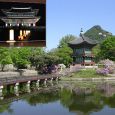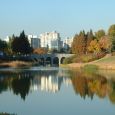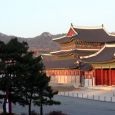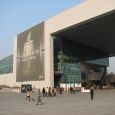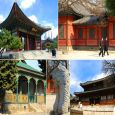Seoul
Advertisement
By plane
Incheon Airport
Most visitors arrive via Incheon International Airport (IATA: ICN), located on Yeongjong Island in the neighboring city of Incheon and covered in detail in its own article.
Gimpo Airport
The closer but older Gimpo Airport caters only to the shuttle services to Tokyo-Haneda, Osaka-Kansai and Shanghai-Hongqiao, as well as domestic flights within South Korea.
By train
Seoul is the northern terminus of the KTX high-speed line. There are three KTX stations within city limits:
Seoul Station for trains to Busan, Ulsan, Kyeongju, Daegu, Daejeon Cheonan/Asan, and Suwon. Accessible via subway lines 1 & 4.
Yongsan Station for trains to Mokpo, Gwangju, Daejeon and Cheonan/Asan. Also on line 1 & 4 (Sinyongsan Station).
The newly added KTX at Youngdeungpo is now running to southern destinations.
By bus
Every weekend approximately 2 million Seoulites leave the city, which goes a long way to explaining why the city has no less than five major intercity bus terminals.
Central City Terminal, also known as Honam Terminal, (Metro Lines 3, 7 or 9, Express Bus Terminal stn). Directly adjacent to the Express terminal, serves buses to North and South Jeolla.
Dong Seoul Bus Terminal Gangbyeon stn (Line 2). Buses to points east of Seoul (Gangwon and some part of North Chungcheong).
By boat
There are ferry services to various points in China from the neighboring port city of Incheon. Currently no services run from Japan directly to Seoul; many Koreans take the coach or KTX train to Busan, where several ferry and hydrofoil options are available.
By car
No matter where in Korea you start your journey, there will be tolled expressways (Gosok Doro) and national highways (Gook Do) that lead to Seoul; the most important one is the Gyeongbu Expressway, linking Seoul with Busan. To avoid the daily traffic jam on the Gyeongbu Highway near Seoul, take Jungbu/2nd Jungbu, Seohaean, or Yongin-Seoul Expressway.
Mount Inwang
This 336-meter hill is home not only to the eponymous Inwang Temple (Inwangsa), but also Seoul's most famous shamanist shrine Guksadang . To get there, take Exit 2 and start climbing uphill following the "Inwang Temple" signs, through the huge construction site (as of 2006) and up through the temple gate. You'll see a map board and several paths, take the left staircase upward, past the bronze bell of Bongwonsa and you'll reach Guksadang. Behind it are several creeks with shamanist offerings and the bizarre rock formation known as the Zen Rocks; there are plenty of trails if you want to poke around, and the Seoul fortress wall can be seen running near the top of the hill. Be careful not to photograph or disturb any rituals you see being performed.
Yeouido Park
More than 30,000 visit it on the weekdays and over 60,000 people visit it on weekends. The size of the park being 230,000 square meters, this giant concrete field was built for military aviation purposes in emergencies. There is a traditional Korean forest, and in many other places you can enjoy concerts, cycling, or taking walks. Hundreds of trees and flowers offer you shade and an opportunity to relax. It is recommended to visit the three ponds. There are also basketball courts, so feel free to stop by and play. For a nominal fee, one can also rent bicycles or rollerblades for use at the park.
Changdeok-gung
This palace is second only to Gyeongbok-gung (the original Gyeongbok-gung was built before Changdeok-gung but wasn't used for as long a time) in historical importance, this was first built in 1405 and was the seat of power between 1618 and 1896. The buildings have all been recently restored and freshly repainted, creating a dazzling but still elegant effect that got the palace listed as an UNESCO World Heritage Site. Buildings of particular note include the blue-roofed Seonjeongjeon, which was the King's office, and the Daejojeon ("Great Making Hall"), his bedchamber, but perhaps most famous of all is the Huwon ("Secret Garden") in the back. Access to the complex is by guided tour only except on Thursdays when only self-guided tours are available in summer from April to August
Gyeongbok-gung
This is Seoul's grandest Joseon Dynasty-era palace and the seat of power for centuries before it was razed in 1592 by a Japanese invasion (and again by the Japanese in 1910). This was the first palace used by the Joseon Dynasty. Large parts have now been restored and the vast grounds also house the Joseon Palace Museum and the Korean Folk Museum
Deoksu-gung
Located in downtown Seoul across the street from City Hall, Deoksu Palace vividly contrasts to the other nearby palaces like Changdeok Palace. Built during the mid-fifteenth century, the architecture of the buildings inside are heavily influenced with Western designs. Hence, you will see a fusion of both Korean and Western architecture. Closed on Mondays.
Changgyeong-gung
Originally built in 1104 as a summer palace for the Kings of the Koryo Dynasty, it became one of the main palaces during the Joseon Dynasty. The palace was used as a temporary home for the King during the time Gyeongbuk Palace was being built. Unlike other palaces that has a North-South orientation, Changgyeong Palace faces East-West. Also, what is famous about this palace is the fact it connects to Jongmyo Shrine, a holy place for the Joseon Dynasty, where sacrificial rites are practiced for previous kings and queens. Closed Tuesdays
Mountains
Seoul offers many excellent opportunities for hiking. The mountains in Seoul are at most 800 metres (3,000 feet), accessible by public transit and the trails range from easy to difficult.
Bukhansan Offers probably the best hiking opportunities in Seoul. It is in the north of Seoul and can be extremely crowded on holidays. To visit a popular area, take line 1 to Dobongsan station.
Gwanaksan Gwanak station, line 1. The sammak temple is located in.
Samseongsan Close to Gwanaksan.
Inwangsan Located in central seo
Boramae Park
Formerly the site of the Korean Air Force Academy, which in 1986 turned into a park - Boramae, or hawk in English, symbolizes the Air Force. The size of the park is about 360,000 square meters and its sports facilities, a small zoo, a pond, and walking paths are well designed. The huge pond, which is 9,000 square meters, is surrounded by willow trees and benches, and people love to come. The pond is full of cool shades during the summer, and is spectacular when snow falls in the winter
Olympic Park
Built for the 1986 Asian Games and the 1988 Seoul Olympics. A lake, a large field covered with the grass, and a square with sculptures are very popular among visitors. It is frequently visited by brides and grooms to take their wedding pictures. There are a couple of courses that are ideal for jogging or walking. In addition, the outdoor stage and the six stadiums are often used for concerts and other special events. Also a well known modern art museum named SOMA Museum is located within the park that features modern artworks of both korean and international artists. the entrance fee for the museum is 3000 won.
April - May
September - October


